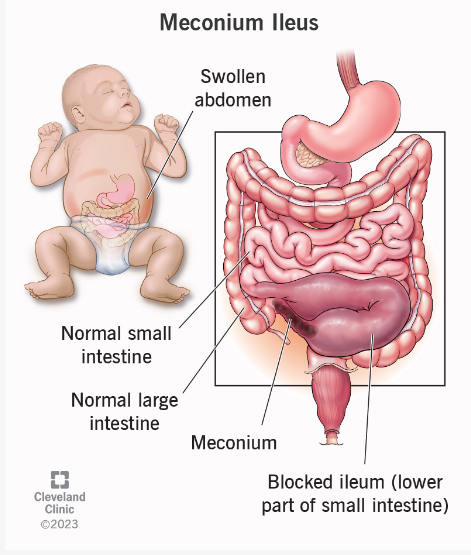You may not know what meconium ileus means, however, the name given to the very first stool (poo) that your baby passes within 24 to 48 hours after birth is called Meconium.
This poo (meconium) is not from the food the babe eats after delivery, like breast milk.
Meconium forms in a baby’s intestines during its development in the womb, and it is made up of materials ingested during that time.
The materials that form what we call meconium have been analysed and found to include these:
- Water
- Amniotic fluid
- Mucus
- Intestinal epithelial cells
- Bile
- Hairs(lanugo)
This mixture creates a dark-coloured, sticky substance that lines the baby’s intestines.
In typical situations, your baby will pass this meconium within 24-48 hours of life. However, in a situation called Meconium ileus, this will not happen.
Table of Contents
What is Meconium Ileus?
Meconium ileus is a condition where a baby cannot pass the meconium after birth because the bowel or intestines are blocked or obstructed.
Causes of Meconium Ileus
This condition occurs when the meconium becomes abnormally thick and sticky, leading to a blockage in the distal ileum (the last part of the small intestine). I wonder if the baby didn’t drink enough water(through the amniotic fluid) to make the meconium soft!
Well, it does not happen or work that way!
Meconium ileus (Baby bowel obstruction) is usually associated with cystic fibrosis—twenty percent of infants with cystic fibrosis present with meconium ileus at birth.
So, when your baby can’t ‘poo’ within 24-48 hours, it is a spoiler alert that he might be having meconium ileus and probably due to cystic fibrosis!!
But while it is a possibility, it’s only sometimes the case. You can look out for symptoms of meconium ileus.
Symptoms of meconium ileus:
Newborns with meconium ileus may show signs of bowel obstruction, such as:
1 Swollen abdomen
2 Vomiting
3 Failure to pass meconium within the first 24-48 hours after birth.
These signs would make a parent or doctor think of meconium ileus. The next step is to perform some tests to confirm or diagnose the condition.
This leads us to the diagnosis of meconium ileus.
Diagnosis of Meconium Ileus

The best way to diagnose this condition is through imaging techniques in a Radiology department.
This is done using a contrast enema, which can reveal a microcolon(narrow large intestine) and impacted meconium.
A contrast (barium enema) is an X-ray imaging used to examine the structure of the rectum, colon, and large intestine.
This procedure involves inserting a small tube into the rectum and filling the colon with a contrast material, such as barium or an iodine solution.
What the doctors see in a contrast enema result of a baby with meconium ileus.
First, you need to understand the anatomy of the body involved. I will explain in simple terms. When we eat food or drink water, it passes from our mouth to the stomach. From the stomach, it moves to the small intestines, first, then to the large intestine, before what remains passes through the anus.
But you must know this: The first part of the small intestine is called the duodenum. That means food or water leaves the stomach and enters the duodenum.
The last part of the small intestine is called the ileum. That means food or water leaves the ileum to enter the large intestine.
This is what happens in meconium ileus.
The meconium gets stuck just before it enters the large intestine, so this happens in the last part of the small intestine, called the ileum. Meconium at the ileum becomes Meconium Ileus!!
So, when a baby begins to feed after birth, such as breast milk and water, the food materials pile up behind the meconium, which is stuck in the ileum.
This pile-up makes the small intestine swell. Because nothing is getting to the large intestine, it collapses and becomes smaller than the small intestine!! That is funny!!
Refer to the image above to understand how the small intestine looks bigger than the large intestine and the point where the meconium blocks the flow of food to the large intestine.
This swelling of the small intestine makes the baby’s belly swell or distend, which is one of the physical signs of meconium ileus.
How would this condition be treated?
Treatment of Meconium Ileus.
Doctors can administer a soluble enema to soften and clear the stuck meconium, or surgery may be indicated in more complicated situations.
Whatever the case, always take your baby to hospital for proper care. Do not make assumptions at home.
There is a condition called Ileal Atresia, which can mimic Meconium Ileus. That is why taking your baby to a hospital for proper care by healthcare professionals is very important.
To understand Ileal Atresia, click here.
Sources
Presentations – Johns Hopkins Cystic Fibrosis Center (hopkinscf.org)
Meconium Ileus: Causes, Diagnosis & Treatment (clevelandclinic.org)
You might s well read common mistakes patients make that affect their lab results

